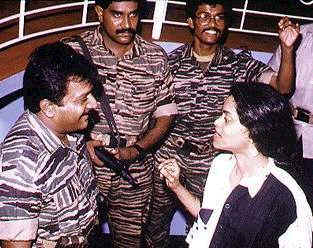 "I
did
not
have
the
intention
to
go
underground,"
he
told
the
Anita
Pratap.
He
said
he
could
have
come
back
to
Chennai
when
Balasingham
was
arrested,
but
he
chose
not
to
do
so
because
he
wanted
to
express
his
"resentment
to
the
deportation
order."
"I
did
not
have
the
intention
to
go
underground,"
he
told
the
Anita
Pratap.
He
said
he
could
have
come
back
to
Chennai
when
Balasingham
was
arrested,
but
he
chose
not
to
do
so
because
he
wanted
to
express
his
"resentment
to
the
deportation
order."Feedback re 1986 killing of TULF MPs Alalasuntharam and Dharmalingam from a reader:
March 29, 2005
Dear
Editor,
In
Chapter
38
the
writer
mentioned
that
the
TULF
MPs'
murder
had
been
carried
out
by
Das.
This
is
totally
untrue.
Sri
Sabaratnam
gave
the
order
to
kill
all
former
TULF
MPs
who
lived
in
Jaffna
at
that
time.
But
Das
refused
to
carry
out
the
order
(kill
Thurairatnam
and
Rajalingam)
and
warned
Bobby
(who
was
in
charge
for
Jaffna
on
that
time)
to
not
kill
anyone
from
Vadamarachi.
These
two
murders
had
been
carried
out
by
Bobby's
group.
I
hope
you
will
put
this
correction
on
your
next
chapter.
Thanks
-----------------------
March 30, 2005
If
you
think
it
is
not
true,
you
can
check
with
Selvam
Adaikalanathan
(Current
TELO
Leader).
I
know
the
person
who
carried
out
this
operation.
The
Tigers
arrested
him
when
they
wiped
out
the
TELO
in
1986.
After
he
was
released,
he
went
to
Norway.
The
Tigers
-
particularly
Vasu
(who
was
killed
in
1987
with
PonnAmman)
-
came
to
know
about
this
matter
when
he
investigated
one
of
the
TELO
cadets
who
was
involved
with
this
operation.
Vasu
discussed
with
me
about
this
matter
as
well
(I
was
also
under
their
custody).
He
told
me
that
initially
they
thought
this
operation
was
carried
out
by
the
Sri
Lankan
army
because
the
Tigers
chased
this
gang,
but
couldn't
catch
them.
The
gang
drove
their
car
towards
Jaffna
Fort
(Kottai).
Therefore
the
Tigers
thought
this
operation
had
been
carried
out
by
the
army
with
the
help
of
some
insiders
and
did
not
want
to
tell
the
public
because
it
would
affect
their
credibility.
-
In
that
period
the
Tigers
used
to
say
"Army
cannot
come
into
the
Peninsula."
I
asked
Vasu
whether
they
are
going
to
take
any
action
against
those
involved
with
this
matter.
He
smiled
and
said
"No,
because
if
you
don't
kill,
one
day
we
will
kill
them.
But
there
is
one
big
difference.
Sri
did
this
for
RAW's
benefit,
we
will
do
it
for
our
benefit."
Thanks
S.
T.
----------------------------------
by T. Sabaratnam
(Volume 2)
Pirapaharan surfaced on 10 September 1985 because he felt that the Sri Lankan Government was benefiting from his absence. He realized that Jayewardene was making use of his absence to manipulate a split between India and the Tamil militants and to damage the militants' image by showing the world that they were anti-peace and anti-democracy.
Pirapaharan acted fast once he surfaced to repair the damage Jayewardene had inflicted on India - Tamil militant relations and on their image. He attended the emergency ENLF leaders’ meeting on 10 September and argued that they should meet Rajiv Gandhi to correct the pro-Sri Lanka tilt that had occurred in Delhi since the Thimpu walkout.
Pirapaharan told Anita Pratap of the Sunday magazine which hit the stands on 29 September that he was in northern Sri Lanka when Balasingham was deported on 23 August. Pirapaharan said he went there to discuss with his lieutenants matters relating to the peace talks, to assess for himself the situation there and to find out the reaction of the people to the peace talks. He said his lieutenants and the public were committed to the achievement of freedom through the establishment of a separate state of Tamil Eelam. They had no faith in Jayewardene.
 "I
did
not
have
the
intention
to
go
underground,"
he
told
the
Anita
Pratap.
He
said
he
could
have
come
back
to
Chennai
when
Balasingham
was
arrested,
but
he
chose
not
to
do
so
because
he
wanted
to
express
his
"resentment
to
the
deportation
order."
"I
did
not
have
the
intention
to
go
underground,"
he
told
the
Anita
Pratap.
He
said
he
could
have
come
back
to
Chennai
when
Balasingham
was
arrested,
but
he
chose
not
to
do
so
because
he
wanted
to
express
his
"resentment
to
the
deportation
order."
Pirapaharan admitted that his remaining inaccessible even when Rajiv Gandhi invited the ENLF leaders to meet him had strained the relations between Rajiv Gandhi and the ENLF. But Pirapaharan insisted that he did so because he wished to convey his dissatisfaction to Balasingham’s deportation. "I strongly felt that the deportation order was unnecessary," he said.
He gave three reasons for surfacing. Asked Anita Pratap:
Q: Then what made you surface again?
Pirapaharan replied:
A: There were many reasons. First, because I was underground there were some negative forces, certain anti-liberation forces, which in my absence were trying to portray us as dangerous terrorists who were opposed to peace talks. Second, there was an attempt to isolate and single us out as hard-liners who wanted only a military solution. Rumours were being floated in the public and in some newspapers which started giving grossly exaggerated and distorted news about us, painting us as dangerous terrorists. Third, the Sri Lankan Government was exploiting my absence and blaming the LTTE for the murder of the TULF ex-MPs.
Pirapaharan gave the fourth reason for his decision to surface at the ENLF leaders meeting. He told the ENLF leaders that their contacts with Rajiv Gandhi had been through Indian intelligence and foreign ministry officials. The officials should have direct contact with him also. They should make use of this opportunity to meet him and explain their position.
Pirapaharan was fully aware that Rajiv Gandhi was irritated over the ENLF’s delay in meeting him. RAW officials have told Balakumar and Pathmanabha in clear terms that the delay had "broken the momentum" of Delhi’s conciliatory efforts. They were also told the delay was the cause for "senseless killings and ceasefire violations," thus putting the blame for the resumption of violence on the militants.
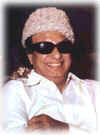 M
G
Ramachandran
M
G
Ramachandran
The ENLF decided at the 10 September meeting to meet MGR before meeting Rajiv Gandhi. Their meeting with MGR took place three days later. At that meeting, the ENLF leaders stressed two matters. Firstly, they impressed on MGR, with the help of video clippings and photographs, that the Jayewardene government was implementing a planned program to destroy the Tamil people of Sri Lanka. They told him the Sri Lankan army and navy were chasing the Tamil people from their traditional villages in the Eastern Province and were populating those areas with Sinhala people. They told MGR that the Sri Lankan government was arming the Sinhalese and getting them to attack the Tamil villagers. They told him the sudden influx of Sri Lankan Tamils into Tamil Nadu was due to this program of genocide.
Secondly, the ENLF leaders told MGR that they were not terrorists. They were freedom fighters. Their prime concern was the safety and security of the Tamil people. They only desired that the Tamil people should live with dignity in their places of habitation, looking after their own needs. They pointed out the political proposals the Sri Lankan Government had so far offered failed to meet the aspirations of the Tamil people. Instead of making District Councils autonomous, the government had made them instruments for the strengthening of the central government control over the Tamils. The ENLF leaders told MGR they expected India to prevail on Jayewardene to end his genocidal program and to offer a package that would genuinely devolve power to the people.
MGR directed the ENLF leaders to meet Rajiv Gandhi and assured them that he would send him his report about his thinking about the problem. He did it that day itself. He informed Rajiv Gandhi about the thinking of the ENLF leaders and his own assessment about the situation in Sri Lanka.
MGR expressed his assessment about the Sri Lankan issue when he met reporters after his meeting with the ENLF leaders. He said he felt that Sri Lanka should take immediate steps to stop Tamil people fleeing to Tamil Nadu. "Thousands of Tamils have come to Tamil Nadu seeking refuge. This should stop." MGR thus turned the focus of the Tamil problem into a predominantly refugee problem. He added that the political proposals Sri Lanka presented at Thimpu would be insufficient to provide the Tamils the safety, security and dignity they require. "Tamils should be left to look after their affairs," he said.
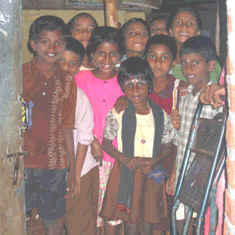 Sri
Lankan
refugee
children
in
India,
2003
Sri
Lankan
refugee
children
in
India,
2003
ENLF leaders reached Delhi on 18 September, the day the 3-month ceasefire lapsed. Before they left Chennai, Lalith Athulathmudali made another master move by announcing the unilateral extension of the ceasefire for another three months. That meant that the ceasefire would continue till 18 December.
The CMC
Bhandari asked the ENLF leaders who met him on 19 September to respond positively to the Sri Lankan unilateral announcement about the extension of the ceasefire. The ENLF leaders told him that the Sri Lankan army was not observing the ceasefire. They gave him a list of the ceasefire violations and said the ceasefire was being used to chase Tamils from their traditional villages in the Eastern Province. They said Sri Lanka was using the ceasefire as a smokescreen to hoodwink India and the world. To extend the ceasefire further a monitoring mechanism should be put in place, they said. Bhandari readily agreed.
Bhandari took the suggestion for a Ceasefire Monitoring Committee seriously. He contacted Lalith Athulathmudali, who reacted positively. "That is a good idea. Anyhow, I will consult the President and come back," he replied. Athulathmudali consulted President Jayewardene and announced Sri Lanka’s willingness to appoint a Ceasefire Monitoring Committee (CMC). Its mechanism was discussed at the second meeting Bhandari had with ENLF leaders on 20 September.
Rajiv Gandhi was pleased with that development. He made a special mention about it during the 90-minute meeting he had with the ENLF leaders on 23 September. Rajiv Gandhi called the decision to set up the CMC "a major step forward." Pirapaharan told him that he was skeptical. "I doubt whether the Sri Lankan government would implement it honestly," he said. Rajiv Gandhi said, "Do not live in the past. We will make it work." Pirapaharan replied, "Let’s wait and see."
Bhandari conducted the negotiations for the establishment of the CMC. The ENLF leaders made two basic demands:
Athulathmudali was not agreeable, but the ENLF leaders insisted on their demands. They told Bhandari that they would not be a party to the creation of anything that lacked power. They told Bhandari that the appointment of committees and commissions was a deceitful strategy Sri Lankan leaders indulge in. "They fool the people with commissions and committees," they told Bhandari.
After haggling for over a week, the Sri Lankan government and the Tamil groups reached an agreement about the setting up of the CMC. They agreed to set up a Ceasefire Monitoring Committee of five members, the government nominating three and the Tamil side two. Lalith Athulathmudali included into the agreement the clause that the CMC "will be expanded to include new members, some from the list suggested by ENLF." Bhandari or the Tamil side failed to understand the purpose of the clause at that time.
The government nominated three members including the well-known administrator Felix Dias Abeysinghe who was asked to function as the CMC secretary. The militants nominated Prof. Karthigesu Sivathamby, chairman, Coordinating Committee of Citizens Committees and Kandaratnam Sivapalan, chairman, Trincomalee Citizens Committee as their nominees.
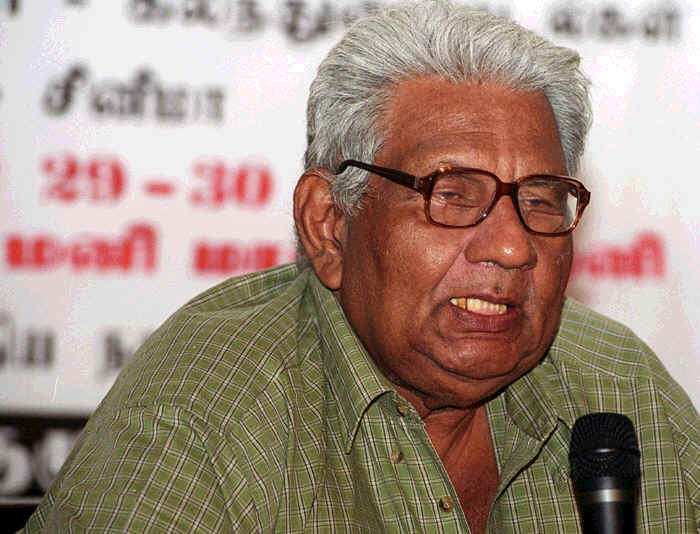 Prof.
K.
Sivathamby,
2004
(picture
courtesy
TamilNet)
Prof.
K.
Sivathamby,
2004
(picture
courtesy
TamilNet)
Rajiv Gandhi announced the establishment of the CMC to the media and said that it was a major advance which presaged an end to the Sri Lankan conflict. He also told the media that President Jayewardene should emulate the Punjab example and work out a political package to accommodate the aspirations of the Tamil people.
President Jayewardene did not relish that condescending statement of Rajiv Gandhi. He also did not like the Sikh parallel. Punjab was a state in India which enjoyed a large measure of autonomy. It even had its own legislative assembly. The Sikhs agitated first for greater autonomy and later for a separate state called Kalistan. Rajiv Gandhi negotiated with the main Sikh party, the Akali Dal, which submitted many demands including the building of a separate capital city for itself. Gandhi conceded most of the demands, including the demand for a separate capital.
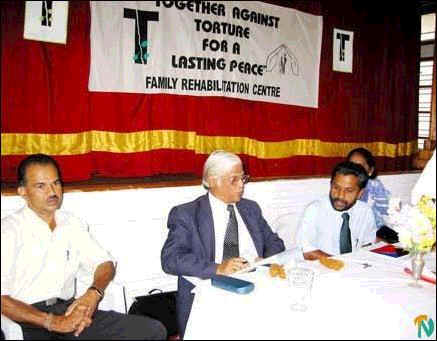 K.
Sivapalan
(white
hair),
2003
K.
Sivapalan
(white
hair),
2003
Rajiv Gandhi ordered a general election in Punjab to allow the people to decide whether they accepted the solution he had worked out with the Akali Dal. Rajiv Gandhi’s Congress Party contested the election which was held on 25 September, two days after his meeting with ENLF leaders. Akali Dal won the election and took over the administration of the state. Rajiv Gandhi hailed the victory of Akali Dal as a victory for democracy.
In Sri Lanka, the situation was completely different. TheTamil majority northeast was governed directly by the Sinhala- dominated central government. For 20 years - 1956 to 1976 - non-violent, democratic agitations, launched by the elected leaders of the Tamil people inside and outside parliament calling for an autonomous region, were put down. Mob violence and state repression were unleashed on them by the governments in power. That bred an armed freedom struggle and the demand for a separate state. That, too, was answered with mob violence and state repression. Under Jayewardene the situation became unbearable. Pogroms in 1977, 1981 and 1983 were targetted to weaken and destroy the Tamil people. This violence resulted in the strengthening of the freedom struggle. Jayewardene’s answer was further repression; portraying and projecting to the world that the Tamil freedom struggle was terrorism.
Naturally, Jayewardene detested the Sikh parallel. He was not prepared to talk to the Tamil leaders with the genuine intention to work out a solution that would grant the Tamils self-rule in their territory. He was only trying to weaken the Tamil freedom struggle and destroy it militarily.
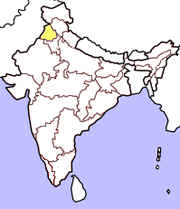 On
17
October,
just
as
the
CMC
had
begun
to
function,
Athulathmudali
announced
the
government
decision
to
expand
its
membership
from
five
to
eleven.
He
did
it
without
consulting
India
or
the
Tamil
militants.
Five
of
the
new
members
were
Sinhalese
and
the
other
a
Muslim.
The
announcement
was
timed
to
coincide
with
the
Bahamas
meeting
of
the
Commonwealth
Heads
of
States
of
Governments
which
began
on
18
October.
On
17
October,
just
as
the
CMC
had
begun
to
function,
Athulathmudali
announced
the
government
decision
to
expand
its
membership
from
five
to
eleven.
He
did
it
without
consulting
India
or
the
Tamil
militants.
Five
of
the
new
members
were
Sinhalese
and
the
other
a
Muslim.
The
announcement
was
timed
to
coincide
with
the
Bahamas
meeting
of
the
Commonwealth
Heads
of
States
of
Governments
which
began
on
18
October.
ENLF leaders protested to Bhandari with whom they were having discussions on a political package. Indian Foreign Affairs Ministry sources said Bhandari was irritated about the expansion of the CMC. The Tamils and Bhandari could not do anything because they did not want to disturb the discussions scheduled for that very day in the Bahamas between Rajiv Gandhi and Jayewardene. Rajiv Gandhi, though informed, chose not to make an issue about the unilateral expansion because he was concentrating his attention on the political proposals. (See Chapter 41 for details}
With the expansion of membership, the CMC was transformed into an instrument of the Sinhalese. The two Tamil members told me that their voice was smothered; the army resented their questioning. One member went to the extent of harassing the Tamil members. The CMC had become a lame duck, they said.
The breaking point came in mid December. A meeting of the CMC was fixed to be held in the Jaffna Fort which was held by the army. The militants had surrounded the Fort and kept it under siege.
"I was on my way to the Fort in a friend’s car. When I was close to the Jaffna Hospital, a helicopter appeared and circled around the Fort. Suddenly it dipped low and fired. A woman who was on her way to the hospital was hit. She died. I was angry. It was a clear violation of the ceasefire agreement.
I protested as I entered the meeting place. Others tried to calm me saying that that was an accident. They failed. I refused to eat the lunch they served. I told them I wanted to leave Fort," Prof. Sivathamby recollected.
Prof. Sivathamby was not in a position to leave the Fort. The militants had begun to retaliate for the helicopter firing. They fired from the direction of the Jaffna city into the Fort. The army officer, Capt. Kotalawela, who was inside the Fort went to Prof. Sivathamby's rescue. Capt. Kotalawela was in regular contact with the LTTE’s Jaffna Commander, Kittu. He informed Kittu that they wanted to take Prof. Sivathamby out of the Fort. Firing stopped. Prof. Sivathamby was led out of the Fort.
"I took the decision, then and there, to resign from the CMC," Prof. Sivathamby recalled.
Sivathamby went to Colombo and informed Abeysinghe about his decision. Sivathamby told him that he wanted to hand over the resignation letter to the President. Abeysinghe wanted him to hand over the resignation letter to him. Prof. Sivathamby declined.
"The President appointed me. I’ll hand over the letter to him," Prof. Sivathamby insisted.
"I am the secretary to the CMC. The President has asked me to accept the letter," Abeysinghe said.
Prof. Sivathamby was determined to send the resignation letter to the President because he wanted to convey his feelings to him.
Sivathamby took Sivapalan, the other Tamil member of the CMC, with him and went to Justice C. Manikkavasagar’s house. Manikkavasagar was then the Chancellor of Jaffna University. Manikkavasagar called the President on the phone and informed him about the resignations and told him "Prof. Sivathamby wants to talk to you" and handed Sivathamby the receiver.
Prof. Sivathamby told him, "Your Excellency! Please be careful in handling our work. If we don’t do this well it might be the last time Sri Lankans will have a hand in solving this problem." And he put the receiver down. Prof. Sivathamby told me that he had been sounding this warning at all the CMC meetings he attended.
Sivathamby met Dixit the next day and informed him about his resignation. Dixit told him not to worry. "Everything is over," he said. He meant the ceasefire. Prof. Sivathamby noted the sour tone in his voice. India had begun to realize what type of people they were dealing with.
The CMC itself had come to the conclusion that everything was over. It reported to President Jayewardene, the only report it issued, that no purpose would be served by the CMC without Tamil representation in it. The CMC collapsed and so did the ceasefire.
Both sides wanted the ceasefire to collapse. They had been arming themselves during the ceasefire. Jayewardene had opted for a military solution and Pirapaharan had prepared the Tamils to face it.
Pirapaharan told Anita Pratap in September that while the government was using the ceasefire to arm itself they also had use for the time. The LTTE and the other militant groups had surrounded all the army camps in the Jaffna peninsula during that period and made their movement difficult.
The Tamil groups complained to Rajiv Gandhi when he returned from the Bahamas about the increase of the membership of the CMC without their consent. They told Gandhi that Jayewardene could not be trusted. "He is not honest in implementing the agreement reached about the Monitoring Committee. How can we trust him over the implementation of any accord reached?" they asked.
Pirapaharan voiced his irritation when the Delhi-based magazine Gentleman questioned him in early November about the Ceasefire Monitoring Committee. He said:
What monitoring committees are you talking about? Have they published a single report? Have they investigated a single instance of cease-fire violation by the rampaging armed thugs of J.R.'s regime? The truth is that he has bought more gunboats from Singapore to kill our fishermen. The truth is that while the talks are going on he is murdering more and more civilians. The Armed Forces, along with the Navy and the Air Force, have conducted military operations.
The ENLF in its memo submitted to Rajiv Gandhi in late November cited the plight of the CMC as one significant example of the deceptions the Sri Lankan government practiced on the Tamils.
Tamils Reject Accord
While the ceasefire was faultering, Delhi continued its effort to work out a political solution. Bhandari and Rajiv Gandhi were keen to build on the Delhi Accord. Rajiv Gandhi invited the leaders of the six Tamil groups that participated in the Thimpu talks for a meeting with him. His intention was to obtain their reaction and then talk to Colombo about it.
India had learnt from the Thimpu talks that its facilitator role of bringing both sides to the negotiation table would not work. Such a method promoted confrontation instead of compromise. India decided to upgrade its role to that of a mediator who would talk to both sides and through persuasion and pressure develop a package of proposals acceptable to both sides. The media termed this method 'proximity talks' because the Indians talked to both sides.
The TULF and PLOTE accepted Rajiv's invitation and the ENLF leaders went underground. The TULF leaders Amirthalingam and Sivasithamparam flew to Delhi on 2 September (Alalasuntharam and Dharmalingam were killed that night) and held extensive talks with Bhandari and Rajiv Gandhi on the Delhi Accord. Rajiv Gandhi told the TULF leaders to give their reactions to the Delhi Accord. They told him the accord was deficient in three major areas - Tamil Homeland, devolution of power in respect of land, and the subject of law and order. They were told to put their objections in writing.
On their return to Chennai, Amirthalingam and Sivasithamparam wrote a joint letter to Rajiv Gandhi informing him that the Tamil people would never comprise on three matters. The letter pointed out the deficiencies:
They were: the integrity of the Tamil homeland, the devolution of power in respect of land and the subject of internal law and order…
With regard to the integrity of the Tamil homeland, the TULF leaders referred to the position they had taken in the letter they wrote Rajiv on 26 July where they said:
The fundamental basis for any solution to the Tamil problem will be the recognition of the right of the Tamil people to rule themselves in their homeland. Serious inroads have been made into these homelands by a policy of planned colonization with Sinhalese carried out by successive Sinhala governments since independence, in the teeth of opposition by the Tamil people and in violation of the solemn undertakings given by Prime Ministers, in the same patterns as Israeli settlements in occupied Palestine.
Amirthalingam and Sivasithamparam said land should be a devolved subject. That was the only way to prevent planned Sinhala colonization of the Tamil homeland.
On the matter of law and order, the TULF leaders said the establishment of regional police, offered under the Delhi Accord, was insufficient. They wanted the entire regional police including the staff officers brought under the control of the Chief Minister.
The TULF leaders pointed out that the safety and security of the Tamil people had emerged as the major problem facing the Tamil people. They suggested three measures to ensure the security of the Tamil people. These measures were:
Rajiv Gandhi was anxious to obtain the reaction of ENLF leaders to the Delhi Accord so that Indian officials could place a complete view of the Tamil side for the consideration of the Sri Lankan government.
Dixit was instructed to make use of Thondaman, who was scheduled to visit his ancestral home in Muna Puthur in Ramanathapuram district in Tamil Nadu, to persuade the ENLF leaders to meet Rajiv Gandhi. Thondaman failed in his attempts to meet ENLF leaders, but he met MGR and his Electricity Minister, Panrutti Ramachandran, on 6 September.
Thondaman met President Jayewardene on 5 September and informed his about his meeting with MGR the next day.
"What shall I tell him about the Delhi Accord?" Thondaman asked Jayewardene.
Jayawardene asked Thondaman to tell MGR that the Delhi Accord was not a final document and could be used as a basis of discussion to work out a solution. Thondaman conveyed that information to MGR and asked Panrutti, who was holding a dialogue with the Tamil militant groups, to persuade ENLF leaders to meet Rajiv Gandhi.
Thondaman told the Hindu after the meeting, "The Working Paper (Delhi Accord) is not a final document. It is the basis for the discussion. If both sides had the will, the proposals could be stretched to cover such points that each one wants."
Indian authorities, during this time, exerted pressure on the Sri Lankan government to restrain its armed forces. They also took parallel steps to urge the Tamil militants, particularly the LTTE, to refrain from planting land mines and ambushing the security forces.
Delhi was very active during this period. It summoned Dixit for consultations and he was there from 7 to 14 September. Delhi had also invited Hector Jayewardene to discuss the TULF reactions to the Accord. Hector Jayewardene was in Delhi from 10 to 13 September. The Foreign Affairs Ministry spokesman told the media that Jayawardene was invited to "further discuss certain matters which figured in the Delhi Accord."
Hector Jayewardene had discussions with Romesh Bhandari and Indian constitutional expert Dr. Balakrishnan on ways and means of meeting the TULF’s three basic demands for a Tamil homeland and power over land and law and order.
On the question of a homeland, Bhandari asked Hector Jayewardene whether some sort of linkage between the Northern and Eastern Provinces could be worked out. Hector Jayewardene first refused to talk about any kind of linkage, but relented after consulting President Jayewardene, saying that, as the District Councils would remain the basic units of devolution of power, Batticaloa, the Tamil majority district in the Eastern Province, could be allowed to work with the Northern Provincial Council.
On the question of land, Hector Jayewardene indicated that they would be flexible during talks. On the question of law and order, he adopted a tough stand. He indicated the government’s opposition to introducing an ethnic ratio in recruitment and for the formation of Tamil and Muslim regiments.
The ENLF Position
ENLF leaders, who reached Delhi on 18 September, held five rounds of talks; two with Romesh Bhandari, a 90-minute meeting with Rajiv Gandhi and two with Foreign Affairs and Defence Ministry officials.
The meeting with Rajiv Gandhi started with Pirapaharan’s explanation of why he did not respond immediately to Rajiv's invitation for a meeting. He told Rajiv Gandhi that he was in northern Sri Lanka when Balasingham was deported. He continued to be in Sri Lanka when the invitation to meet Rajiv was conveyed to him. He said he did not respond because he was not happy about the deportation. He added that he delayed his acceptance of the invitation to signify his displeasure.
"I did not want to avoid meeting you. In fact, I wanted to meet you. That’s why I have come here," Pirapaharan told a smiling Rajiv Gandhi.
Then Pirapaharan pointed out that the Indian decision to deport Balasingham was wrong. He told Rajiv Gandhi the decision to walk out of the Thimpu talks was his and that of the other ENLF leaders. "It was a collective decision. All that Balasingham did was to convey that decision to our delegates at Thimpu," he said.
"I do all the thinking and planning in the LTTE. As I am bad in English, Balasingham conveys my views. He does not influence my decisions," Pirapaharan said.
As they did at their meeting with MGR, the ENLF leaders focused their presentation on Sri Lankan army excesses and the inadequacy of Sri Lanka’s proposals. They presented a well-documented report on Sri Lanka’s program to chase Tamils from the eastern province and alter its demographic composition so as to deny the Tamils their homeland.
Rajiv Gandhi and Bhandari showed their interest in talks with the Sri Lankan government and told the militant leaders to come up with their proposals for a solution. "Come up with a starting paper," Rajiv Gandhi told them.
Pirapaharan
told
Rajiv
Gandhi
that
past
experience
and
history
showed
that
Jayewardene
would
not
come
up
with
a
genuine
settlement.
Jayawardene
was
staging
a
drama
to
show
that
he
was
a
peaceful
man.
Pirapaharan
warned
Rajiv
Gandhi
not
to
trust
Jayewardene.
He
told
Rajiv
Gandhi
that
India
should
adopt
a
stringent
attitude.
He
pledged
support
for
India’s
effort
to
work
out
a
peaceful
solution,
but
said
India
should
try
harder.
Pirapaharan
made
it
clear
to
Rajiv
Gandhi
and
Indian
officials
that
he
believed
firmly
that
Tamil
Eelam
is
the
only
practicable
solution
to
the
Tamil
problem.
He
was
prepared
to
accept
an
alternative
solution
only
out
of
his
respect
for
India.
And
the
alternative
he
was
prepared
to
accept
was
self-rule
for
the
Tamils
within
a
united
Sri
Lanka.
Pirapaharan
told
the
Indian
Prime
Minister
that
the
Sinhala
leadership
would
never
agree
to
such
a
solution.
Pirapaharan made use of his stay in Chennai and Delhi to clear the LTTE of the charge that it had killed Alalasuntharam and Dharmalingam.
He told the Sunday which asked:
Q: Did the LTTE kill the two TULF ex-MP's? The Indian intelligence agencies are positive that you were responsible.
A: We are not responsible for the killing. What can we do if Indian intelligence agencies make such claims? Immediately after it took place, we denied the claim made by the Sri Lanka government that we were responsible. The ENLF also issued a denial. Even if the Indian intelligence agencies claim that we are responsible, the people in Jaffna know that we have not done it. Maybe the Indian intelligence agencies have assumed that we did it without any evidence. Because I had gone underground, they may have come to such conclusions.
If we had done it, we would have claimed responsibility, giving our reasons for doing it. We undertake an operation only on the basis of our conviction. So, if we had done it we would not have gone about hiding the fact. For instance, when we shot Alalasuntharam we claimed we had done it. We did not kill him because we thought it was unnecessary. We punished him for his anti-social activities; he had a hand in the cooperative fraud. We produced evidence of his embezzlement. Incidentally, a lot of the documents exposing his nefarious activities were set ablaze on the cooperative premises. We also claimed responsibility when we shot Anandarajah. When the Sri Lanka government announced a reward of Rs. 5 lakhs for information leading to the arrest of his killers, the people of Jaffna came to know the basis of his relationship with the Sri Lanka government. They kept quiet, fully understanding why we had killed him. Anandarajah was planning to hold a cricket match with the armed forces at a time when they were killing our people, arresting young Tamil boys indiscriminately, burning Tamil property and raping Tamil women. We had to do away with him because the government was using the impending cricket match as propaganda to give the impression to the world that the Tamil civilians have very cordial relations with the Sri Lanka armed forces and that the ethnic problem is something created by a handful of militants.
Q: Could not the ex-TULF MPs have been killed by some rebel LTTE members?
A: Absolutely not. Nothing happens in the LTTE without my permission.
But before telling this to the Sunday Pirapaharan met Yogeswaran and Thangathurai. Pirapaharan told them that the LTTE did not kill Alalasuntharam and Dharmalingam. Pirapaharan told them that he was particularly upset at the killing of Dharmalingam because he had always admired Dharmalingam's simple and exemplary life.
Pirapaharan spoke about this meeting to the Sunday. He told the magazine:
I met TULF leaders and assured them that we had not done this killing and that they need not worry about facing such consequences from us. I told them that just because we had shot Alalasundaram some time ago, it did not mean that we were against the TULF.
However, I pointed out to them that the gap between them and the younger generation was widening most alarmingly. The younger generation look upon them as betrayers who have given up the struggle for Eelam. The gap is widening all the more because they are not in Eelam facing the people. They have been completely isolated from the realities in Eelam. So, as long as they remain isolated from the Tamil people, they are likely to face such drastic action from the younger generation. The reality is that if I were to give up the Eelam struggle I would face similar action from them.
The Sunday reporter Anita Pratap continued to probe Pirapaharan based on the information that Rajiv Gandhi was about to rescind the deportation order on Balasingham, but decided not to do so when the two TULF parliamentarians were killed.
Pirapaharan made use of his answer to take an aside on RAW. He said,
We have no connection with the killing. If the Indian government does not rescind the orders because it assumes that we killed the TULF MPs, then it is its mistake. There is no point in punishing us. They should punish the agency that is really guilty so that such incidents do not occur again.
Pirapaharan’s meeting with Rajiv Gandhi and Romesh Bhandari, his public denial of any involvement in the murder of the former TULF MPs and the planned attacks by the army and the Sinhala Home Guards on Tamil civilians and the consequent influx of refugees into Tamil Nadu helped, as far as the Tamils were concerned, correct India’s tilt towards Colombo.
This correction was reflected in the statements Rajiv Gandhi made at the press meet on 27 September held at Rashtri Bhavan (President’s House) in Delhi. He said:
Sri Lanka should emulate the solution we have achieved in the Punjab problem. There is no short-term solution to the Tamil problem. Sri Lanka should adopt a long-term approach. It is a political problem. Military means to achieve a solution will only complicate the matter.
India continued with its political approach. Rajiv Gandhi kept pressing the Tamil side to come up with a ‘starting paper.’ He asked the Tamil side at a public meeting he addressed in Tamil Nadu in mid-October, "Where is the starting paper?"
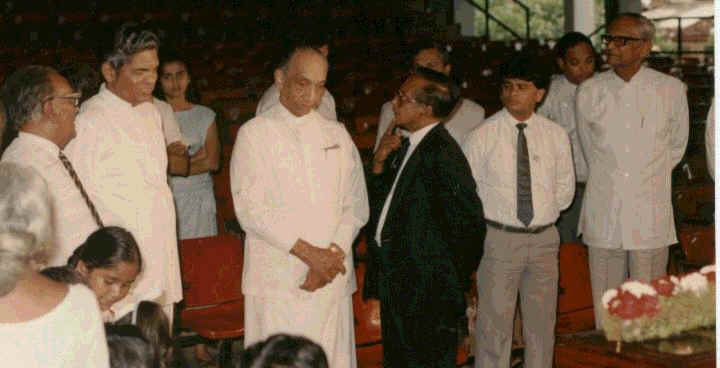
Lalith Athulathmudali and JR Jayawardene (4th & 5th from left) at JCA Corea's funeral
India also continued to press Jayewardene to improve his ‘package of proposals’ to meet the basic demands of the Tamil people. Romesh Bhandari flew to Colombo on 30 September to inform Jayawardene about the talks he and Rajiv Gandhi had had with the ENLF delegation a week earlier. Bhandari told Jayewardene that the militants were prepared to give up their demand for a separate state and accept a political solution if an autonomous Tamil region was created in the northeast.
Bhandari’s visit was intended to prepare the ground for a dramatic announcement during the Commonwealth Heads of Government meeting to be held in the Bahamas in the third week of October. Rajiv Gandhi was anxious to make such an announcement. He thought that such an announcement would boost India’s and his standing globally.
The Indians were then unaware that Jayewardene had mapped out his own strategy. He had planned to weaken India and to force it to distance itself from the Tamil militants. He also wanted to make use of the meeting in the Bahamas to acquire weapons for his planned military solution.
Bhandari’s 30 September visit to Colombo achieved nothing. Jayewardene made use of Bhandari to get his son Ravi and his wife Penny invited to tour India. He also managed to get them to meet Rajiv Gandhi. The purpose of the meeting was to inform Rajiv Gandhi through his son that Sri Lanka was in possession of a detailed account of India’s training of and assistance to Tamil militants.
Jayewardene followed that up that effort with a letter to Rajiv Gandhi thanking him for the courtesies he and the Indian government extended to his son and daughter-in-law. The letter written on 3 October was to prepare the ground for talks he intended to have with Rajiv Gandhi later that month in the Bahamas.
The following extracts are from the letter:
We have been receiving reports from reliable sources that there is a regular movement of weapons, explosives and manpower from South India to Sri Lanka, particularly after the ceasefire became operative. It is between Rameswaram and Point Calimere and also from points north of Calimere including Vetharaniyam and Nagapattinam that much of the movement take place.
If it is in any way possible to increase your coast guard patrols in Indian waters to prevent these movements from taking place, it would be of great assistance to us; it will also help in a long way to resolve the major problem of terrorism that faces us. We have to increase our defensive mechanism much more to make detections and ultimately to stop this illegal traffic. This requires a large expenditure of capital in training personnel which will take quite a long time. If you consider it useful, I can send the Commander of the Navy or his representative to brief your relevant officials in this problem that faces us. With kind regards and hoping to meet you at Bahamas.
In this courteous letter, Jayewardene pushed Rajiv Gandhi to be defensive more than two weeks before they met. Jayawardene had stopped Rajiv Gandhi from raising his own militarization program as a subject of discussion.
Pirapaharan gave an interview to Gentleman in the third week of November when ENLF leaders visited Delhi for talks with Romesh Bhandari.
Gentleman: How do you assess the present situate in Sri Lanka?
Pirapaharan: The present political situation in Sri Lanka is very critical. The Tamil nation is facing a genocide onslaught. The Sri Lankan Armed Forces are continuing their rampage on the Tamilian masses. Our people are subjected to massacres, mass arrests, arson, looting and rape. Thousands of them are uprooted from their traditional homelands and made refugees. Under the guise of a cease-fire, the Sri Lankan State has embarked on a policy of ruthless repression, military domination and annihilation of our people. The present chauvinistic Sinhala leadership has no genuine interest in bringing about a fair and just solution through peaceful negotiations, but is committed to militarily subjugating the Tamil people. Such a policy has made the present, situation very critical and dangerous.
Gentleman: How do you view the present pace of negotiations between the Sri Lankan Government and the representatives of the Tamil people?
Pirapaharan: The peace negotiations have been a futile exercise. This is a drama enacted by the Jayewardene Government to deceive the world. Although Jayewardene poses as a lover of peace, he does not desire a peaceful settlement. So far he has failed to offer any substantial proposals that would satisfy the political aspirations of our people. Under the facade of a peace process he has unleashed military terror aimed at the genocidal destructionof our people.
Gentleman: So for all practical purposes, do you think that the peace process has failed?
Pirapaharan: Well, talks so far have failed to bear any positive results.
Gentleman: Does it mean that now there is no possibility of any negotiated settlement to the problem?
Pirapaharan: It depends.. .
Gentleman: On India's position?
Pirapaharan: In a sense, yes.
By January 1986, Rajiv Gandhi has tired of dealing with Jayewardene. Jayawardene had cornered Rajiv Gandhi at the inaugural session of SAARC in Dhaka during 7 -10 December, 1985.
Next
Chapter 40. Operation Green Arrow
To be posted April 8